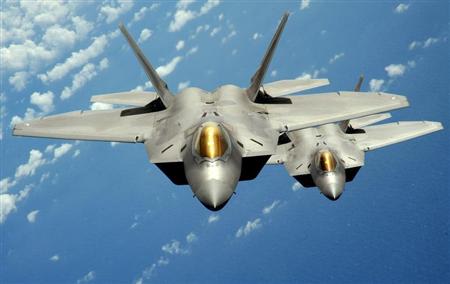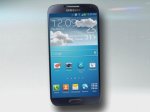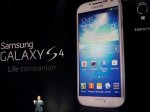- Russian-American crew taking short cut to space station Reuters - Fri, Mar 29, 2013
- Solar plane to set out to cross U.S. in early May Reuters - Thu, Mar 28, 2013
- UK scientists develop safer foot-and-mouth vaccine Reuters - Wed, Mar 27, 2013
- 8 Tech Products That Won’t Make it to 2014 LiveScience.com - 12 hrs ago
- Finally, the Bacon Condom Has Arrived LiveScience.com - 14 hrs ago
- Worst Allergy Season Ever? LiveScience.com - 14 hrs ago
- Rare Chinese Porpoises Dive Toward Extinction LiveScience.com - 15 hrs ago
Sunday, March 31, 2013
U.S. F-22 stealth jets join South Korea drills amid saber-rattling - Yahoo! News
U.S. F-22 stealth jets join South Korea drills amid saber-rattling - Yahoo! News:
'via Blog this'
 WASHINGTON (Reuters) - The United States sent F-22 stealth fighter jets to South Korea on Sunday to join military drills aimed at underscoring the U.S. commitment to defend Seoul in the face of an intensifying campaign of threats from North Korea.
WASHINGTON (Reuters) - The United States sent F-22 stealth fighter jets to South Korea on Sunday to join military drills aimed at underscoring the U.S. commitment to defend Seoul in the face of an intensifying campaign of threats from North Korea.
'via Blog this'
U.S. F-22 stealth jets join South Korea drills amid saber-rattling
Reuters – 5 hrs ago- View PhotoReuters/Reuters - Two U.S. Air Force F-22 Raptor stealth jet fighters fly near Andersen Air Force Base in this handout photo dated August 4, 2010. REUTERS/U.S. Air Force/Master Sgt. Kevin J. Gruenwald/Handout less
 WASHINGTON (Reuters) - The United States sent F-22 stealth fighter jets to South Korea on Sunday to join military drills aimed at underscoring the U.S. commitment to defend Seoul in the face of an intensifying campaign of threats from North Korea.
WASHINGTON (Reuters) - The United States sent F-22 stealth fighter jets to South Korea on Sunday to join military drills aimed at underscoring the U.S. commitment to defend Seoul in the face of an intensifying campaign of threats from North Korea.
The advanced, radar-evading F-22 Raptors were deployed to Osan Air Base, the main U.S. Air Force base in South Korea, from Japan to support ongoing bilateral exercises, the U.S. military command in South Korea said in a statement that urged North Korea to restrain itself.
"(North Korea) will achieve nothing by threats or provocations, which will only further isolate North Korea and undermine international efforts to ensure peace and stability in Northeast Asia," the statement said.
Saber-rattling on the Korean peninsula drew a plea for peace from Pope Francis, who in his first Easter Sunday address called for a diplomatic solution to the crisis on the Korean peninsula.
"Peace in Asia, above all on the Korean peninsula: may disagreements be overcome and a renewed spirit of reconciliation grow," he said, speaking in Italian.
Tensions have been high since the North's young new leader, Kim Jong-un, ordered a nuclear weapons test in February, breaching U.N. sanctions and ignoring warnings from North Korea's closest ally, China, not to do so.
That test, North Korea's third since 2006, drew further U.N. and bilateral sanctions designed to pressure the impoverished North to stop its nuclear weapons program. Pyongyang responded to the new steps by ratcheting up warnings and threats of war.
North Korea said on Saturday it was entering a "state of war" with South Korea, but Seoul and its ally the United States played down the statement from the official KCNA news agency as the latest in a stream of tough talk from Pyongyang.
In a rare U.S. show of force aimed at North Korea, the United States on Thursday flew two radar-evading B-2 Spirit bombers on practice runs over South Korea.
On Friday, Kim signed an order putting the North's missile units on standby to attack U.S. military bases in South Korea and the Pacific, after the stealth bomber flights.
The F-22 jets will take part in the annual U.S.-South Korea Foal Eagle military drills, which are designed to sharpen the allies' readiness to defend the South from an attack by North Korea, the U.S. military said.
The U.S. military did not say how many of the planes were flown to South Korea from Kadena Air Base in Okinawa. The statement described Sunday's deployment as part of routine shifts of air power among bases in the Western Pacific that U.S. forces have been conducting since 2004.
Japan's Kyodo news agency quoted the top Japanese government spokesman, Yoshihide Suga, as condemning Pyongyang for "aggressive provocation" after Kim's ruling party newspaper, the Rodong Sinmun, identified U.S. military bases in Japan as targets for attack.
The two Koreas have been technically in a state of war since a truce that ended their 1950-53 conflict. Despite its threats, few people see any indication Pyongyang will risk a near-certain defeat by re-starting full-scale war.
(Reporting by Paul Eckert; Editing by Eric Beech)
- Reuters
By David Chance SEOUL (Reuters) - The United States flew two nuclear-capable stealth bombers on practice …
- All Comments
- My Comments
Saturday, March 30, 2013
8 Tech Products That Won’t Make it to 2014 - Yahoo! News
8 Tech Products That Won’t Make it to 2014 - Yahoo! News:
'via Blog this'
'via Blog this'
8 Tech Products That Won’t Make it to 2014
By Avram Piltch, Laptopmag.com | LiveScience.com – 12 hrs agoRELATED CONTENT
View Photo
Windows RTView Photo
Ubuntu Phone
Who can forget when HP spent $1.2 billion for Palm, only to give up on its entire ecosystem just 57 days after launching the first webOS tablet? Does anyone even remember Microsoft’s Kin phones, which disappeared in 2010 after just 48 days on the market? That’s faster than most Kardashian marriages.
Right now, there are a number of highly touted new technologies getting ready to take their place in the history books . . . as footnotes. These eight tech products aren’t likely to make it to 2014.
Windows RT
When Microsoft first announced that it was making a version of Windows 8 for ARM-based processors, we were excited by the possibility of a new generation low-power devices. Unfortunately, rather than doing what it does best -- providing a flexible platform for partners and developers -- Microsoft put Windows RT on lockdown, preventing it from running desktop applications and limiting it to a handful of devices that don’t cost much less than their Windows 8 counterparts.
Even worse, the company gave Windows RT the same exact UI as Windows 8, potentially confusing consumers who buy RT devices thinking that they’re getting the “real” Windows. Sales for Windows RT devices have been so bad and return rates so high that chip-makers like Nvidia have publicly voiced their disappointment while partners like Samsung have cancelled planned devices. Analyst firm IDC predicts Windows RT will achieve only a 1.9 percent marketshare in 2013 which will grow to just 2.7 percent by 2017.
What Microsoft should do is make Windows RT compatible with x86 desktop platforms and work with OEMs to lower the price of devices so they are price-competitive with Android tablets. What it will do is kill this failing platform by the end of the year.
More: 10 Must-Buy Tablets
Chromebook Pixel
Chromebooks as a category are doing very well, with the $249 Samsung Chromebook dominating Amazon’s list of best-selling laptop computers. With low prices and long battery life, Chromebooks are the 2013 answer to the netbook. However, just as consumers wouldn’t have paid $1,300 for a premium quality Eee PC in 2009, they won’t pay that much for a nicer Chromebook today.
When we reviewed the $1,299 Chromebook Pixel, we were impressed with its beautiful high-res touch screen, comfy keyboard and attractive design. However, for over $1,000 users want a complete desktop OS like Windows or Mac OS X. After its overpriced device fails to catch on with consumers, Google will put the Pixel out to pasture and stop selling it by the end of this year.
Ubuntu Phone
Firefox OS, Tizen, Ubuntu Phone: how many new operating systems does the mobile phone market need? This year, all three of these new platforms are due to make their debut, competing with iOS, Android, Windows Phone and BlackBerry 10.
The PC market has room for an infinite number of platforms, because users can install the OS of their choice on any computer, even one they built themselves. On phones, your platform is worthless if both hardware vendors and carriers, both of whom are extremely conservative, don’t support it.
Samsung is throwing its weight behind Tizen and may even use the OS instead of Android on all its smartphones at some point. Several carriers and handset makers, including Alcatel and ZTE, have already shown off working Firefox OS phones that real carriers plan to sell outside the U.S. It looks like Ubuntu Phone, despite its attractive UI and ability to run desktop apps, will be the odd man out.
ASUS Taichi and Descendants
Dual-screen laptops have a rich but checkered history, with Lenovo, Kohjinsha and Acer all briefly experimenting with them. ASUS now offers its own unique dual-screen design with the ASUS Taichi 21, a notebook that has 11.6-inch screens on both sides of its lid. While the backfacing screen doesn’t give the users any additional screen real estate, they can show presentations or movies to people sitting across from them, a boon for business. However, even with just one screen activated, the Taichi’s battery life was a weak 4 hours and 37 minutes, a time which shrank to just over 3 hours with both displays on.
For $1,600, users expect more, but they won’t get it from ASUS. The innovative company knows when to drop a concept that isn’t working and Taichi isn’t. I don’t expect to see a sequel to this Gigli-like laptop.
Motorola Droid Line
From the long-lasting RAZR Maxx HD to the compact RAZR M, Motorola’s Droid line of Android phones are among the best in the business. Unfortunately, the company only sells its best products on Verizon, dumping mid-range and low-end handsets on the other carriers. To be a real success in the smartphone business, you need to sell the same flagship product across multiple carriers like Samsung has done with its Galaxy S III.
Now that Google owns Motorola, the Android-maker expects to “drain the pipe” of current phones in development and start focusing on creating a few high-quality devices. I expect that part of that strategy will be an end to Verizon-only products as Motorola seeks to broaden distribution and simplify its product line. If the company comes out with any more Verizon exclusives this year, they’ll be the last.
More: 10 Best Android Phones
Small-Time Smart Watches
Does anyone remember the Nokia 770? How about the Pepper Pad? Both devices were slate computers that came out the year before the first iPad. However, after Apple changed the market, these half-baked early stabs at a tablet were toast.
Today, we’re on the verge of a revolution in smart watches. Apple, Samsung, LG and Google are all reportedly working on major products for release this year. Meanwhile, early players like the pricey, unstable I’m Watch and the grayscale-only Pebble have either delivered unstable performance or a mediocre set of functions. By the end of the year, most of these first-gen watches will have been swept out of the market by big-name competitors with more polished products.
HTC Zoe
HTC’s not the clear market leader in smartphones by any stretch, but it’s still trying to build support for its own proprietary short video format, which it calls Zoe. If you own an HTC One phone, you can record 3-second clips and then share them on HTC’s Zoe share site. Because Zoe is not a standard, the clips can’t be embedded in popular social media sites like Facebook or Twitter.
If you have some other brand of phone or even a different HTC handset, you can’t capture Zoes. Meanwhile, Twitter’s Vine videos, which are twice as long as Zoes, are becoming extremely popular and will likely soon extend beyond iOS to other platforms. Animated GIFs are also very popular, which is why Samsung has a special Cinema mode on the Galaxy S4 that lets you create them. I can’t imagine HTC continuing to push Zoes when its users want to create the same kind of short videos as all of their friends. short video niche.
Windows 8 Sliders
Sometimes, you have a good idea on paper that just doesn’t work in the plastic and metal world of hardware design. Since the launch of Windows 8, we’ve seen a number of hybrid systems that look like tablets but have keyboards and stands that slide out of the screen to turn them into clamshell shaped notebooks. Unfortunately, systems like the Sony VAIO Duo 11 and MSI Slider S20 offer the worst of both worlds: a thick, heavy tablet and a notebook with an uncomfortable keyboard and no wrist support. The MSI Slider S20 doesn’t even have a touchpad or pointing stick. Even worse, most of these devices cost a lot more than the combination of devices they’re meant to replace as users could buy both an iPad and a $700 notebook for the price of the $1,199 Duo 11.
While we don’t have sales numbers for sliders specifically, we know that few consumers want high-priced, uncomfortable devices. Manufacturers will catch on and, if there are still any sliders selling in the fall, this holiday season will be their last.
More: Top 25 Windows 8 Apps
This story was provided by Laptopmag.com, a sister site to LiveScience. Follow Avram Piltch onTwitter, Google+ or Facebook. Follow LAPTOPMAG on Twitter, Google+ or Facebook.
- 5 Ways The Galaxy S4 Makes the iPhone 5 Look Ancient
- The Rodney Dangerfields of Tech: 7 Brands That Deserve More Respect
- Failure to Launch: 5 Most Embarrassing Tech Events
MORE SCIENCE NEWS
Subscribe to:
Comments (Atom)












































































